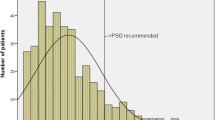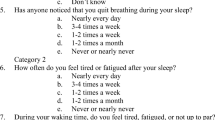Abstract
Obstructive sleep apnoea (OSA) is a condition characterised by repetitive upper airway collapse during sleep. The condition carries a range of health sequelae that can prove fatal in cases with co-existing risk factors for the condition, such as obesity and hypertension. Utilisation of a high-performance screening tool for OSA is thus important. A retrospective audit using the ESS and Stop-Bang scores, alongside Apnoea–Hypopnea Index values, for patients who underwent polysomnography over 1 year. Multinomial logistic regression was used to compare the predictive abilities of ESS, SBM, and body mass index (BMI) for the patient outcome groups, “None” (No OSA), “Notreat” (OSA not requiring treatment) and “treat” (OSA requiring treatment). The influences of age, gender and BMI on outcome group were also assessed. 126 bariatric and 66 non-bariatric patients were included. Multinomial logistic regression failed to demonstrate predictive ability of ESS. A higher Stop-Bang score significantly increases the risk being in the “treat” group. In addition, male gender, greater age and a higher BMI each individually increase the risk of OSA requiring treatment. Stop-Bang failed to demonstrate predictive significance when age and gender were controlled for. ESS is not an appropriate screening tool for OSA. Stop-Bang, however, remains a useful screening tool, with the ability to detect patient with OSA in need of treatment. Further study may benefit the development and implementation of a concise and more specific screening tool that considers high evidence-based risk factors for OSA, including male gender, greater age and raised BMI.
Similar content being viewed by others
References
Sanchez-de-la-Torre M, Mediano O, Barcelo A et al (2012) The influence of obesity and obstructive sleep apnea on metabolic hormones. Sleep Breath 16(3):649–656
Shamsuzzaman AM, Gersh BJ, Somers VK (2003) Obstructive sleep apnea: implications for cardiac and vascular disease. JAMA 290(14):1906–1914
Marin JM, Carrizo SJ, Vicente E, Agusti AGN (2005) Long-term cardiovascular outcomes in men with obstructive sleep apnoea–hypopnoea with or without treatment with continuous positive airway pressure: an observational study. Lancet 365(9464):1046–1053
Al Lawati NM, Patel SR, Ayas NT (2009) Epidemiology, risk factors, and consequences of obstructive sleep apnea and short sleep duration. Prog Cardiovasc Dis 51(4):285–293
Romero-Corral A, Caples SM, Lopez-Jimenez F, Somers VK (2009) Interactions between obesity and obstructive sleep apnea: implications for treatment. Chest 137(3):711–719
Young T, Palta M, Dempsey J, Skatrud J, Weber S, Badr S (1993) The occurrence of sleep-disordered breathing among middle-aged adults. N Engl J Med 328(17):1230–1235
Bixler EO, Vgontzas AN, Ten Have T, Tyson K, Kales A (1998) Effects of age on sleep apnea in men: I. Prevalence and severity. Am J Respir Crit Care Med 157(1):144–148
Bixler EO, Vgontzas AN, Lin HM et al (2001) Prevalence of sleep-disordered breathing in women: effects of gender. Am J Respir Crit Care Med 163(3 Pt 1):608–613
Duran J, Esnaola S, Rubio R, Iztueta A (2001) Obstructive sleep Apnoea–Hypopnea and related clinical features in a population-based sample of subjects aged 30 to 70 yr. Am J Respir Crit Care Med 163(3 Pt 1):685–689
Kim J, In K, Kim J et al (2004) Prevalence of sleep-disordered breathing in middle-aged korean men and women. Am J Respir Crit Care Med 170(10):1108–1113
Sharma SK, Kumpawat S, Banga A, Goel A (2006) Prevalence and risk factors of obstructive sleep apnea syndrome in a population of Delhi, India. Chest 130(1):149–156
Peromaa-Haavisto P, Tuomilehto H, Kossi J et al (2016) Prevalence of obstructive sleep apnoea among patients admitted for bariatric surgery. A prospective multicentre trial. Obes Surg 26(7):1384–1390
Yeh PS, Lee YC, Lee WJ et al (2010) Clinical predictors of obstructive sleep apnea in asian bariatric patients. Obes Surg 20(1):30–35
Liao P, Yegneswaran B, Vairavanathan S, Zilberman P, Chung F (2009) Postoperative complications in patients with obstructive sleep apnea: a retrospective matched cohort study. Can J Anaesth 56(11):819–828
Young T, Skatrud J, Peppard PE (2004) Risk factors for obstructive sleep apnea in adults. JAMA 291(16):2013–2016
Johns MW (1991) A new method for measuring daytime sleepiness: the epworth sleepiness scale. Sleep 14(6):540–545
Chung F, Yegneswaran B, Liao P et al (2008) STOP questionnaire: a tool to screen patients for obstructive sleep apnea. Anesthesiology 108(5):812–821
Osman EZ, Osborne J, Hill PD, Lee BW (1999) The epworth sleepiness scale: can it be used for sleep apnoea screening among snorers? Clin Otolaryngol Allied Sci 24(3):239–241
Kingshott RN, Sime PJ, Engleman HM, Douglas NJ (1995) Self assessment of daytime sleepiness: patient versus partner. Thorax 50(9):994–995
Chung KF (2000) Use of the epworth sleepiness scale in chinese patients with obstructive sleep apnea and normal hospital employees. J Psychosom Res 49(5):367–372
Punjabi NM (2008) The epidemiology of adult obstructive sleep apnea. Proc Am Thorac Soc 5(2):136–143
Ibrahim AS, Almohammed AA, Allangawi MH et al (2007) Predictors of obstructive sleep apnea in snorers. Ann Saudi Med 27(6):421–426
Stradling JR, Crosby JH (1991) Predictors and prevalence of obstructive sleep apnoea and snoring in 1001 middle aged men. Thorax 46(2):85–90
Chung F, Elsaid H (2009) Screening for obstructive sleep apnea before surgery: why is it important? Curr Opin Anaesthesiol 22(3):405–411
Silva GE, Vana KD, Goodwin JL, Sherrill DL, Quan SF (2011) Identification of patients with sleep disordered breathing: comparing the four-variable screening tool, STOP, STOP-bang, and epworth sleepiness scales. J Clin Sleep Med 7(5):467–472
Nagappa M, Liao P, Wong J et al (2015) Validation of the STOP-bang questionnaire as a screening tool for obstructive sleep apnea among different populations: a systematic review and meta-analysis. PLoS ONE 10(12):e0143697
Chung F, Abdullah HR, Liao P (2016) STOP-bang questionnaire: a practical approach to screen for obstructive sleep apnea. Chest 149(3):631–638
Chung F, Liao P, Farney R (2015) Correlation between the STOP-bang score and the severity of obstructive sleep apnea. Anesthesiology 122(6):1436–1437
Chiu H, Chen P, Chuang L et al (2016) Diagnostic accuracy of the Berlin Questionnaire, STOP-BANG, STOP, and epworth sleepiness scale in detecting obstructive sleep apnea: a bivariate meta-analysis. Sleep Med Rev 211:1309–1312
Chudeau N, Raveau T, Carlier L et al (2016) The STOP-BANG questionnaire and the risk of perioperative respiratory complications in urgent surgery patients: a prospective, observational study. Anaesth Crit Care Pain Med 35(5):347–353
Fassbender P, Herbstreit F, Eikermann M, Teschler H, Peters J (2016) Obstructive sleep apnea-a perioperative risk factor. Dtsch Arztebl Int 113(27–28):463–469
Nagappa M, Wong J, Singh M, Wong DT, Chung F (2017) An update on the various practical applications of the STOP-bang questionnaire in anesthesia, surgery, and perioperative medicine. Curr Opin Anaesthesiol 30(1):118–125
Nahapetian R, Silva GE, Vana KD, Parthasarathy S, Quan SF (2016) Weighted STOP-bang and screening for sleep-disordered breathing. Sleep Breath 20(2):597–603
Chung F, Yang Y, Brown R, Liao P (2014) Alternative scoring models of STOP-bang questionnaire improve specificity to detect undiagnosed obstructive sleep apnea. J Clin Sleep Med 10(9):951–958
Farney RJ, Walker BS, Farney RM, Snow GL, Walker JM (2011) The STOP-bang equivalent model and prediction of severity of obstructive sleep apnea: relation to polysomnographic measurements of the Apnea/Hypopnea index. J Clin Sleep Med 7(5):459–465
NHS Health Research Authority. Governance Arrangements for Research Ethics Committees (GAfREC). http://www.hra.nhs.uk/resources/research-legislation-and-governance/governance-arrangements-for-research-ethics-committees/. Accessed May 2017 (updated May 2011)
Thong JF, Pang KP (2008) Clinical parameters in obstructive sleep apnea: are there any correlations? J Otolaryngol Head Neck Surg 37(6):894–900
Chervin RD, Aldrich MS (1999) The epworth sleepiness scale may not reflect objective measures of sleepiness or sleep apnea. Neurology 52(1):125–131
Mediano O, Barcelo A, de la Pena M, Gozal D, Agusti A, Barbe F (2007) Daytime sleepiness and polysomnographic variables in sleep apnoea patients. Eur Respir J 30(1):110–113
Rosenthal LD, Dolan DC (2008) The epworth sleepiness scale in the identification of obstructive sleep apnea. J Nerv Ment Dis 196(5):429–431
ICSD (2005) International classification of sleep disorders: diagnostic and coding manual, 2nd edn. American Academy of Sleep Medicine, Westchester
Tan A, Yin JDC, Tan LWL, van Dam RM, Cheung YY, Lee C (2016) Predicting obstructive sleep apnea using the STOP-bang questionnaire in the general population. Sleep Med 27-28:66–71
Chung F, Yang Y, Liao P (2013) Predictive performance of the STOP-bang score for identifying obstructive sleep apnea in obese patients. Obes Surg 23(12):2050–2057
Remya KJ, Mathangi K, Mathangi DC et al (2017) Predictive value of craniofacial and anthropometric measures in obstructive sleep apnea (OSA). CRANIO® 35(3):162–167
Deflandre E, Degey S, Brichant JF, Poirrier R, Bonhomme V (2016) Development and validation of a morphologic obstructive sleep apnea prediction score: the DES-OSA score. Anesth Analg 122(2):363–372
Deflandre E, Degey S, Brichant J et al (2017) Pre-operative ability of clinical scores to predict obstructive sleep apnea (OSA) severity in susceptible surgical patients. Obesity Surg 27(3):716–729
Vittinghoff E, McCulloch CE (2007) Relaxing the rule of ten events per variable in logistic and cox regression. Am J Epidemiol 165(6):710–718
Author information
Authors and Affiliations
Contributions
BP designed study, ran analysis, wrote first draft and contributed to ongoing writing. AJP designed analysis, ran analysis, interpreted results, and contributed to ongoing writing. GD designed study, interpreted results, and contributed to ongoing writing.
Corresponding author
Ethics declarations
This study was limited to the secondary analysis of data that were collected as part of standard clinical practice, and anonymised to all researchers.
Conflict of interest
The authors declare that they have no conflict of interests.
Ethical approval
All data were collected as part of normal care and these routinely collected data were anonymous to all researchers, conforming to the Governance Arrangements for Research Ethics Committee (GAfREC) standards [36].
Informed consent
For this type of study formal consent is not required.
Electronic supplementary material
Below is the link to the electronic supplementary material.
Rights and permissions
About this article
Cite this article
Panchasara, B., Poots, A.J. & Davies, G. Are the Epworth Sleepiness Scale and Stop-Bang model effective at predicting the severity of obstructive sleep apnoea (OSA); in particular OSA requiring treatment?. Eur Arch Otorhinolaryngol 274, 4233–4239 (2017). https://doi.org/10.1007/s00405-017-4725-2
Received:
Accepted:
Published:
Issue Date:
DOI: https://doi.org/10.1007/s00405-017-4725-2




